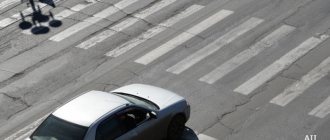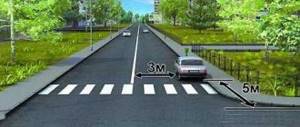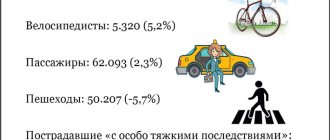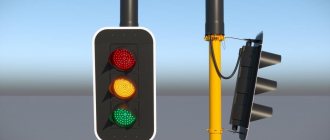Last modified
The method of allowing pedestrians to pass, according to clause 14.1 of the traffic rules, has changed with the latest innovation on November 14, 2014.
Previously, the Rules stated that the driver is obliged to “give way” to a pedestrian, but now there is an obligation to “give way”, and you will understand what the difference is below. Change in clause 14.1 of the Rules
| Was | New edition |
| 14.1. The driver of a vehicle approaching an unregulated pedestrian crossing must slow down or stop before the crossing in order to allow pedestrians crossing the roadway or entering it to cross. | 14.1. The driver of a vehicle approaching an unregulated pedestrian crossing is obliged to give way to pedestrians crossing the road or entering the roadway (tram tracks) to cross. |
When should you give way to a pedestrian when turning at an intersection?
Quite often on the road you can see the following situation. Cars turn left at a signalized intersection. At the same time, even before they have completed the turn, the pedestrian traffic light at the intersection turns green. Since pedestrians immediately begin to walk on the road, drivers give way to them (as they should do according to the rules).
13.1. When turning right or left, the driver must give way to pedestrians and cyclists crossing the roadway onto which he is turning.
However, there are several interesting points that drivers often overlook.
Firstly, when turning, the driver must give way to all pedestrians crossing the road . Even if pedestrians cross a red light or violate other rules. And if an accident occurs with a pedestrian while turning a car, the driver will be at fault in any case. Although in some cases the second culprit will be the pedestrian.
Secondly, drivers must give way to pedestrians. Unfortunately, some drivers do not understand this and create traffic jams through their actions.
Let's look at an example. The driver turns left, and the traffic light for pedestrians on the road he intersects turns green. There is not a single pedestrian at the crossing. But the driver is no stranger! He sees the green signal! So he waits until the red pedestrian signal comes on. With his car, he blocks the road being crossed and prevents other cars from passing, causing a traffic jam.
Therefore, I emphasize once again that a pedestrian is a person, not a traffic light . A pedestrian traffic light is intended only for pedestrians. The driver should not pay attention to such a traffic light at all, much less wait for its red signal.
Comments and clarifications to clause 14.1 of the traffic rules
So, we’ll start with how to allow pedestrians to pass at the crossing in 2021.
How to give way to a pedestrian?
As can be seen from the quote in paragraph 14.1 above, pedestrians must give way. Until November 2014, there was a discrepancy between the traffic rules and the Code of Administrative Offenses: the first ordered pedestrians to let pass, the second punished for failure to yield to the road. Therefore, they were brought into compliance with a corresponding change. But what was the catch?
The problem is that the term pass is not described in any way in the Traffic Rules. But there is a definition of giving way in the new traffic regulations.
The driver must not interfere with the pedestrian. According to clause 1.1 of the Rules, this means that he should not force him to change the speed and/or direction of movement precisely through his own fault. Please note that in the context of giving way, an important condition is: your movement trajectories with the pedestrian must intersect simultaneously in space and time - that is, if you do not give way, you will hit him or force the pedestrian to stop/run away. In any case, on the initiative of the pedestrian, he changes the speed and trajectory, or you use the body of your car to change these physical properties, clause 14.1 of the traffic rules will be violated.
Thus, according to the rules, pedestrians should be allowed to pass like this:
- You approach the crossing and see that the pedestrian has already started crossing. If he is not yet on the roadway, then the driver is not obligated to give way to him.
- You are obliged to stop or slow down so that the pedestrian crosses the road without changing either the trajectory or speed because of you. Please note that if he changed his mind about crossing and thus changed the trajectory and speed, it is not your fault. But if you are afraid of you approaching sharply, then options are possible, alas, at the discretion of the inspector.
- As soon as the pedestrian has left the intersection of your trajectories, you can drive. You have no obligation to wait until he leaves the roadway completely. Let us draw your attention once again - there is an obligation to give way, and it is fulfilled.
In the diagrams below, you did not interfere with the pedestrian, and fully complied with the requirement of paragraph 14.1.
- If you pass without interfering with a pedestrian when he crosses far from you on the other side of the road:
- If you pass before the pedestrian has completed the crossing, but let him pass:
- If the pedestrian changed the trajectory and/or speed of movement on his own initiative:
But this is a theory, but in practice...
If a camera has recorded a pedestrian’s failure to pass, then the fact of giving way to him does not matter - if you are at a pedestrian crossing and the pedestrian is on the roadway, a fine will be issued. This is a significant shortcoming today (more precisely, it is probably a trick by TsAFAP, which is why such fines need to be appealed).
But in practice, the traffic police inspector will try to fine you in any case if the pedestrian is already on the road. Alas, the traffic police officers play on drivers’ ignorance of the rules of the road, and this is their most common “conception.”
Therefore, the above comments will only help you if you have a video recorder, the recording from which can confirm the absence of an obstacle created for a pedestrian and compliance with clause 14.1 of the traffic rules, and as a result, avoid a fine for not allowing a pedestrian to pass. Just inform the inspector that you have a registrar and your intention to appeal the fine if he still insists on not allowing you to pass. Rest assured, he knows exactly the interpretation of 14.1.
If there is no registrar, then we explain the following:
- witness testimony will be strong if the witnesses are not your relatives, not passengers,
- the inspector is obliged to comprehensively consider the case of an administrative violation (Article 26.11 of the Administrative Code), which means that, if possible, he is obliged to involve the pedestrian himself as a witness,
- The Supreme Court of the Russian Federation not so long ago ruled that a protocol on a violation alone is not enough, and this document in itself is not evidence, therefore the inspector needs evidence of the pedestrian’s refusal to pass (when appealing, it is better to remind about this court decision).
According to the new rules of 2021, the inspector has the right to immediately issue a resolution. And if you do not agree with the violation, then he is obliged to draw up a protocol. In it, indicate the inspector’s violations. Also, if he did not explain to you Article 51 of the Constitution (no one is obliged to testify against himself or his immediate relatives) and Article 25.1 of the Administrative Code (on the right to get acquainted with the case materials), then also indicate this. If the inspector refuses to draw up a protocol, you can indicate this in the resolution.
Clarifications and comments
Let's figure out how to clear pedestrians. As can be understood from the Rules, the driver must give way. Before the changes in 2014, traffic rules and the Administrative Code were not consistent with each other. The rules forced pedestrians to let pass, and the Code of Administrative Offenses prescribed punishment for not giving way. Therefore, legislators made amendments to make these regulations appropriate to the situation. But what was the confusion?
The question is that the concept of giving way is not explained in the traffic rules, but how to give way is described in detail there. The driver should not interfere with pedestrians and force them to change the direction of movement or walking speed.
Keep in mind that the concept of “give way” contains an important factor. Your paths of movement with the person crossing the road must intersect immediately in time and trajectory. In other words, if you don't give him the opportunity to cross the road, you will collide with him, or force him to change direction and speed. As a result, clause 14.1 of the Rules will be violated.
Taking into account the above, we can approve the following procedure for pedestrians:
- You approached a zebra crossing, and a pedestrian stepped onto it. If he is not yet on the roadway, then the driver should not yet give way.
- You must slow down or stop to allow the person to cross the road without changing the direction and speed of walking because of you. Then it won't be your fault. But if a pedestrian is frightened by a rapidly approaching car, then a traffic police officer can punish you by issuing a fine.
- When the pedestrian has passed the line of your path, you can continue moving. You are not obliged to wait until he goes all the way, but only to yield to him. And you did it.
The pictures below show that the driver does not interfere with the pedestrian, and complies with traffic regulations, clause 14.1.
If you are driving when a pedestrian has started crossing on the other side of the roadway:
If you cross the crossing before the pedestrian has finished crossing the road:
If a pedestrian in the middle of the road voluntarily decides to go back:
What happens in practice
If you did not let a pedestrian pass, and this violation was recorded by a video camera, then it does not matter whether you gave way to him or not. If you are on a zebra crossing in the photo, and the pedestrian has not yet crossed the road, then expect punishment. Today, such a defect in cameras exists, and these decisions can be challenged in court.
In practice, traffic police officers try to fine drivers in any situation when a pedestrian is on the road. They take advantage of the fact that not all drivers know the traffic rules, and often cheat on this.
The recommendations listed may help if you have a DVR installed on your car . His video recording can prove that you did not interfere with the pedestrian and did not violate clause 14.1 of the Rules. Therefore, in this way you can avoid a fine. You just need to tell the inspector that you have a video recorder, and you will appeal the fine. Most employees know all the intricacies of traffic rules, and paragraph 14.1 in particular.
If your car does not have a DVR, then the following information will be useful to you:
- The testimony of witnesses will have weight if they are not relatives and were not sitting in the car with you.
- The inspector must objectively consider the violation case, and, if possible, may involve the pedestrian as a witness.
- Only one protocol drawn up by a traffic police officer is not enough evidence. This was stated in the Supreme Court of Russia. The inspector must provide other evidence that the pedestrian was not allowed through. If you appeal the decision in court, you must remember this fact.
According to the new traffic rules, a traffic police officer can immediately issue a resolution. If you disagree, a protocol is drawn up, and in it you must describe all the employee’s violations. In addition, if he did not explain Art. 51 of the Constitution, as well as Art. 25.1 of the Administrative Code, then this fact must also be noted in the protocol. If the inspector refuses to draw up a protocol, this must be indicated in the resolution.
Important note!
- This article provides basic information, but each case is different.
- In 92% of all situations there are important nuances that can affect the outcome of the entire case.
- An experienced lawyer will study all the materials of the case and indicate in which direction to move.
Therefore, our website employs on-duty legal consultants who delve into each case and are aimed at solving it.
Ask a Question
or consult toll-free (Moscow), (St. Petersburg), 8 (all of Russia).
Arbitrage practice
- The Altai Regional Court upheld the driver’s complaint against the traffic police inspector’s ruling that he did not interfere with a pedestrian on the road; the inspector did not draw up a report, despite challenging the violation of clause 14.1, and the witness was not interviewed. To prove his case, the driver provided a video recording. The court took into account that the driver complied with the requirement to give way to the pedestrian, although both were crossing the roadway at the same time.
- But another court upheld the traffic police officer’s fine, despite the driver’s same arguments.











